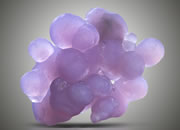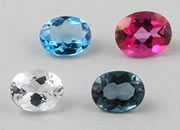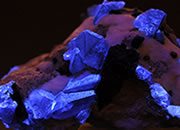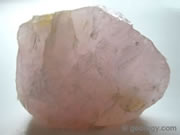Tourmaline
Earth's most colorful mineral and gem material.
Author: Hobart M. King, PhD, GIA Graduate Gemologist

Colorful tourmaline crystals: A scatter of small tourmaline crystals in pretty colors from Afghanistan, suitable for faceting very small stones. Some of them are bicolor and a few are oriented to show pleochroism, with the color looking down the long axis of the crystal being much darker than when looking at the crystal in side view.
What is Tourmaline?
Tourmaline is the name of a large group of boron silicate minerals. These minerals share a common crystal structure and similar physical properties - but vary tremendously in chemical composition. The wide range of compositions and color zoning within crystals causes tourmaline to occur in more colors and color combinations than any other mineral group.
Tourmaline is one of the world's most popular gemstones and it serves as a birthstone for the month of October. Because of its popularity, tourmaline is easy to find in jewelry stores. Well-formed tourmaline crystals are also valued by mineral specimen collectors. Specimens with attractive colors and crystal forms can sell for thousands of dollars.
Physical Properties of Tourmaline |
|
| Chemical Classification | Boron silicate |
| Color | Black is the most common color. Also occurs in blue, green, yellow, pink, red, orange, purple, brown, and colorless. Single crystals are often color-zoned. |
| Streak | White when softer than the streak plate. Colorless when harder than the streak plate. |
| Luster | Vitreous |
| Diaphaneity | Transparent to translucent to nearly opaque |
| Cleavage | Indistinct |
| Mohs Hardness | 7 to 7.5 |
| Specific Gravity | 2.8 to 3.3 (varies with changes in chemical composition) |
| Diagnostic Properties | Lack of visible cleavage, prismatic crystals with rounded triangular cross-sections that are often striated, vibrant colors, pleochroism. |
| Chemical Composition | (Ca,Na,K,[vacancy]) (Li,Mg,Fe+2,Fe+3,Mn+2,Al,Cr+3,V+3)3 (Mg,Al,Fe+3,V+3,Cr+3)6 ((Si,Al,B)6O18) (BO3)3 (OH,O)3 (OH,F,O) |
| Crystal System | Trigonal |
| Uses | A popular gemstone and mineral specimen |
Table of Contents

Tourmaline Crystals on Cleavelandite: A large mineral specimen consisting of prismatic tourmaline crystals on cleavelandite with quartz and lepidolite. The tourmaline crystals are color zoned with red tourmaline at the base that sharply transitions to blue-green along their length. From the Pederneira Mine of Minas Gerais, Brazil. Measures 21 x 15 x 14 cm. Specimen and photo by Arkenstone / www.iRocks.com.
Geologic Occurrence of Tourmaline
Tourmaline most commonly occurs as an accessory mineral in igneous and metamorphic rocks. Large, well-formed crystals of tourmaline can form in cavities and fractures during hydrothermal activity. Tourmaline is a hard and tenacious mineral. That enables it to persist during stream and beach transport as durable grains in sediments and sedimentary rocks.
Tourmaline Crystals
The most spectacular tourmaline crystals are formed by hydrothermal activity. These crystals form when hot waters and vapors carry the elements needed to form tourmaline into pockets, voids, and fractures, which offer an open space for crystal growth. The tourmaline crystals formed in these cavities range in size from tiny millimeter crystals to massive prisms weighing over 100 kilograms.
One rich pocket of nice tourmaline crystals can yield mineral specimens and gem materials worth millions of dollars. Many mineral collectors and gem hunters have become wealthy by discovering just one of these treasure-filled cavities.
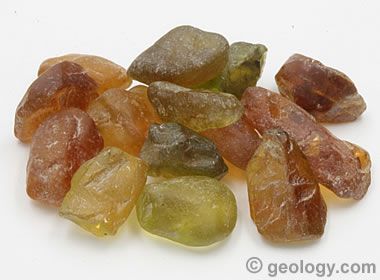
Alluvial tourmaline: About 30 carats of stream-rounded tourmaline rough from Tanzania in yellow, orange, and green colors.
Alluvial Tourmaline
Tourmaline has a Mohs hardness of 7 to 7 ½, and that hardness makes it a durable sediment granule. Tourmaline is also relatively resistant to chemical weathering. So, particles of tourmaline weathered from igneous or metamorphic rocks can persist in a stream and can be transported long distances from their source area.
Tourmaline gem rough is mined from stream sediments in many parts of the world, often by artisanal miners. It generally occurs as small granules and pebbles that that have been rounded by the abrasion of stream transport. Tourmaline is often one of many different minerals produced from a single mining location.
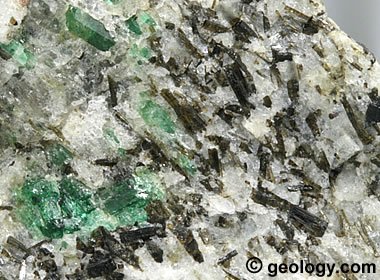
Accessory tourmaline: A specimen of the Crabtree Pegmatite from North Carolina, showing black prismatic tourmaline and green emerald crystals in a matrix of white feldspar and quartz. The width of this view is about two inches.
Tourmaline as Accessory Mineral
The most common occurrence of tourmaline is as an accessory mineral in igneous and metamorphic rocks. It often occurs as millimeter-size crystals scattered through granite, pegmatite, or gneiss. In this mode of occurrence, tourmaline rarely makes up more than a few percent of the rock's volume. The variety of tourmaline most often found as an accessory mineral is black schorl.
Tourmaline Sources
Brazil has been the world's leading source of tourmaline for nearly 500 years. In the 1500s Portuguese explorers obtained green and blue tourmaline from indigenous people and from panning streams in search of gold. They thought that these colorful stones were emeralds and sapphires and sent them back to Portugal, where they were cut into gems and used to make jewelry for royalty and wealthy citizens. (Tourmaline was not recognized as a distinct mineral until 1793.) [1]
Beginning in the late 1800s, a steady stream of tourmaline discoveries have been made in the pegmatite deposits of Minas Gerais, Brazil. Since then, millions of carats of tourmaline have been produced in a wide range of colors, including much bicolor material. This diverse stream of tourmaline from Brazil has been the most important source for the worldwide gem and jewelry market. [2]
The first commercial gemstone mine in the United States followed an 1821 discovery of tourmaline near the town of Paris, Maine. Over the past 200 years, significant amounts of pink and green tourmaline have been produced from dozens of Maine localities.
The most important source of tourmaline in the United States has been the tourmaline mines of southern California. Tourmaline has been mined there since the late 1800s. On the basis of cumulative dollar value, tourmaline has been the most important gem material mined in California. Most of this production occurred over 100 years ago in Riverside and San Diego Counties. Tons of red tourmaline was mined there and shipped to China, where it was used to make snuff bottles, carvings, jewelry and many other items. Today, a little tourmaline is being produced by small-scale mining. The miners today sell much of their best production as mineral specimens.
Today, discoveries of tourmaline of various kinds are made in Afghanistan, Mozambique, Namibia, Nigeria, Pakistan, Tanzania, the United States and other countries. These provide the market with a constantly changing supply of gem tourmaline and mineral specimens.
Physical Properties of Tourmaline
Tourmaline has a few properties that can aid in its identification. If you have a tourmaline crystal, identification should be easy.
- Tourmaline has a prismatic crystal habit and often has obvious striations that parallel the long axis of a crystal.
- Tourmaline crystals often have triangular or six-sided cross-sections with rounded edges.
- Tourmaline crystals are often color zoned through their cross-sections or along their length.
- Tourmaline can be pleochroic with the darkest color viewing down the C-axis and lighter color viewing perpendicular to the C-axis.
Don't despair if your suspected tourmaline is an accessory mineral in an igneous or metamorphic rock. It often occurs in these rocks as tiny prismatic crystals. Get a hand lens and look for striations and rounded cross-sections.
Tourmaline has indistinct cleavage, so any specimen with obvious cleavage is probably not tourmaline. Color might not be helpful. The most common tourmaline color is black, but the mineral occurs in all colors of the spectrum.

Tourmaline: Six faceted tourmaline gemstones from Africa. Clockwise from top left: A blue-green oval weighing 5.5 carats; emerald-cut chrome tourmaline, 1.51 carats; green round, 1.87 carats; pink emerald cut, 1.04 carats; pink-orange emerald cut, 1.88 carats; red cushion cut, 3.34 carats. (Photos are not to scale.) Photos courtesy of The Rare Gemstone Company.
Tourmaline Chemistry
Tourmaline is a complex boron silicate mineral with a generalized chemical composition of:
Letters in the formula above represent positions in the atomic structure of tourmaline that can be occupied by ions listed below.
 X = Ca, Na, K, [] ([] = vacancy) X = Ca, Na, K, [] ([] = vacancy) Y = Li, Mg, Fe+2, Fe+3, Mn+2, Al, Cr+3, V+3 Y = Li, Mg, Fe+2, Fe+3, Mn+2, Al, Cr+3, V+3 Z = Mg, Al, Fe+3, V+3, Cr+3 Z = Mg, Al, Fe+3, V+3, Cr+3 T = Si, Al, B T = Si, Al, B V = OH, O V = OH, O W = OH, F, O W = OH, F, O |
The complex formula and many substituting ions produce the large number of minerals in the tourmaline group. The International Mineralogical Association has recognized 32 different tourmaline minerals based upon the chemical composition of solid solution series end members. These minerals are listed in the table below.
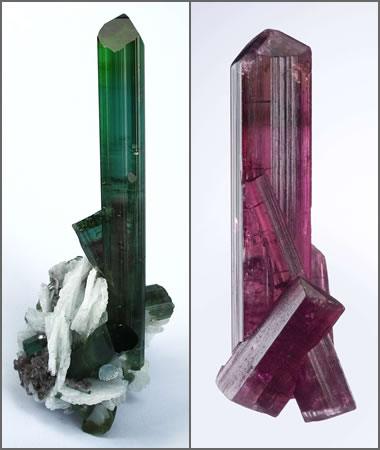
Tourmaline crystals: Tourmaline crystals often have many fractures and inclusions, but these crystals exhibit wonderful clarity and very rich color. They also show the striations along the long axis of the crystals that are characteristic of tourmaline. The blue-green cluster on the left sits atop cleavelandite with purple lepidolite, and it measures 13 cm tall. The rubellite cluster on the right measures 6.7 cm tall. Specimens and photos by Arkenstone / www.iRocks.com.

The best way to learn about minerals is to study with a collection of small specimens that you can handle, examine, and observe their properties. Inexpensive mineral collections are available in the Geology.com Store. Image copyright iStockphoto / Anna Usova.
Tourmaline Group Minerals | |
| [] = vacancy | |
| Mineral | Composition |
| Adachiite | CaFe3Al6(Si5AlO18)(BO3)3(OH)3OH |
| Bosiite | NaFe3(Al4Mg2)Si6O18(BO3)3(OH)3O |
| Chromium-dravite | NaMg3Cr6Si6O18(BO3)3(OH)3OH |
| Chromo-alumino-povondraite | NaCr3(Al4Mg2)Si6O18(BO3)3(OH)3O |
| Darrellhenryite | NaLiAl2Al6Si6O18(BO3)3(OH)3O |
| Dravite | NaMg3Al6Si6O18(BO3)3(OH)3OH |
| Elbaite | Na2(Li3,Al3)Al12Si12O36(BO3)6(OH)6(OH)2 |
| Feruvite | CaFe3(MgAl5)Si6O18(BO3)3(OH)3OH |
| Fluor-buergerite | NaFe3Al6Si6O18(BO3)3O3F |
| Fluor-dravite | NaMg3Al6Si6O18(BO3)3(OH)3F |
| Fluor-elbaite | Na2(Li3,Al3)Al12Si12O36(BO3)6(OH)6F2 |
| Fluor-liddicoatite | Ca(Li2Al)Al6Si6O18(BO3)3(OH)3F |
| Fluor-schorl | NaFe3Al6Si6O18(BO3)3(OH)3F |
| Fluor-tsilaisite | NaMn3Al6Si6O18(BO3)3(OH)3F |
| Fluor-uvite | CaMg3(Al5Mg)Si6O18(BO3)3(OH)3F |
| Foitite | [](Fe2Al)Al6Si6O18(BO3)3(OH)3OH |
| Lucchesiite | Ca(Fe)3Al6Si6O18(BO3)3(OH)3O |
| Luinaite-(OH) | (Na,[])(Fe,Mg)3Al6Si6O18(BO3)3(OH)3OH |
| Magnesio-foitite | [](Mg2Al)Al6Si6O18(BO3)3(OH)3OH |
| Maruyamaite | K(MgAl2)(Al5Mg)Si6O18(BO3)3(OH)3O |
| Olenite | NaAl3Al6Si6O18(BO3)3O3OH |
| Oxy-chromium-dravite | NaCr3(Mg2Cr4)Si6O18(BO3)3(OH)3O |
| Oxy-dravite | Na(Al2Mg)(Al5Mg)Si6O18(BO3)3(OH)3O |
| Oxy-schorl | Na(Fe2Al)Al6Si6O18(BO3)3(OH)3O |
| Oxy-vanadium-dravite | NaV3(V4Mg2)Si6O18(BO3)3(OH)3O |
| Povondraite | NaFe3(Fe4Mg2)Si6O18(BO3)3(OH)3O |
| Rossmanite | [](LiAl2)Al6Si6O18(BO3)3(OH)3OH |
| Schorl | NaFe3Al6Si6O18(BO3)3(OH)3OH |
| Tsilaisite | NaMn3Al6Si6O18(BO3)3(OH)3OH |
| Uvite | CaMg3(Al5Mg)Si6O18(BO3)3(OH)3OH |
| Vanadio-oxy-chromium-dravite | NaV3(Cr4Mg2)Si6O18(BO3)3(OH)3O |
| Vanadio-oxy-dravite | NaV3(Al4Mg2)Si6O18(BO3)3(OH)3O |
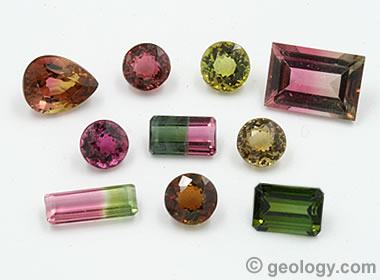
Faceted tourmaline: A collection of faceted tourmalines of various colors. Some of these stones exhibit multiple colors because they were cut from color-zoned crystals. Two are pink and green bicolor stones known as "watermelon tourmaline." Bicolor and pleochroic tourmalines are favorite stones of many jewelry designers because they can be used to make especially interesting pieces of jewelry. The small round stones weigh about 0.5 carat each. The watermelon in the lower left corner weighs 0.61 carat.
Names Used for Tourmaline Gems
A table above lists the names and chemical compositions for 32 different members of the tourmaline mineral group. These names are based upon the chemical composition of the mineral. Because it can be impossible or impractical to determine the chemical composition of a large number of specimens or even a single specimen, the generic name "tourmaline" is typically used for any mineral in the tourmaline group in the field, the classroom, the office, or even in a laboratory.
Tourmaline is one of the most popular gemstones because it occurs in every color of the spectrum. Jewelers and gemologists use trade names for different colors of tourmaline to simplify communications with their customers. These names work much better in a jewelry store than the mineralogical names in the table above!
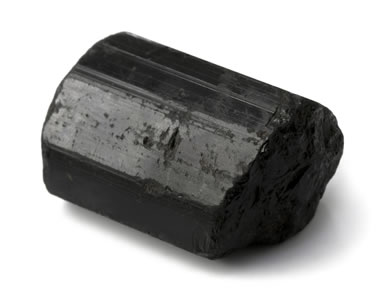
Schorl: Schorl, a black tourmaline, is the most commonly found variety of tourmaline. It occurs as an accessory mineral in many igneous and metamorphic rocks. It is occasionally cut as a gem. Image copyright iStockphoto / J-Palys.
 Red tourmaline is sold as "rubellite". Red tourmaline is sold as "rubellite". Blue tourmaline is sold as "indicolite". Blue tourmaline is sold as "indicolite". Green tourmaline colored by chromium or vanadium is often sold as "chrome tourmaline". Green tourmaline colored by chromium or vanadium is often sold as "chrome tourmaline". Black tourmaline is sold as "schorl". Black tourmaline is sold as "schorl". For other tourmaline colors, the name of the color is usually used as an adjective. For example, "pink tourmaline" or "purple tourmaline." "Yellow tourmaline" is sometimes sold as "canary tourmaline". For other tourmaline colors, the name of the color is usually used as an adjective. For example, "pink tourmaline" or "purple tourmaline." "Yellow tourmaline" is sometimes sold as "canary tourmaline". |
"Color names" make the language of tourmaline gems simple for jewelry consumers. If jewelry stores sold tourmaline gems by their scientific names, the chemical composition of each gem would need to be determined to assure that the names used to offer them for sale were absolutely accurate. This would create confusion, waste time and be an enormous expense. Tourmaline might not be very popular if the names challenged consumers - and even jewelers!
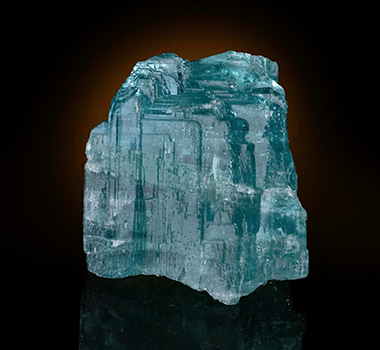
Paraiba Tourmaline: A small rough crystal of the famous "Paraiba" tourmaline from the Batalha Mine in the state of Paraiba, Brazil. The spectacular blue color is caused by trace amounts of copper in the mineral. This specimen measures 1.5 x 1.3 x 0.9 centimeters. Specimen and photo by Arkenstone / www.iRocks.com.
"Paraiba" - The Most Valuable
The name "Paraiba" perks up the ears of people who like tourmaline. In 1989 and 1990, spectacular bright blue to bright green elbaite tourmaline, colored by trace amounts of copper, was found in pegmatite pockets at mines in the states of Paraiba and Rio Grande do Norte, Brazil.
Later, violet specimens containing traces of both copper and manganese were found. The color of these gems was remarkable. Many people began to describe them with adjectives such as "electric" and "neon" because the colors were so saturated and vivid.
The material was informally called "Paraiba" after the locality. The beautiful gems were soon selling for over $2000 per carat, and news about them spread throughout gemstone markets.
People loved the gems, their colors, and their exotic name. Prices for faceted gems of the highest quality material in sizes over one carat escalated to over $10,000 per carat. "Paraiba" quickly became the most popular and most valuable tourmaline.
The initial rage over these gems was all about the character of their color. Soon, people anxious to cash in were using the name "Paraiba" for any tourmaline found in the state of Paraiba - hoping that it would boost the price of what they were selling.
Gems of similar appearance were found in Nigeria in 2001 [3], and some people immediately applied the name to them - again in the hope that it would boost their value. More were discovered in Mozambique in 2005. [3] People with blue or green tourmaline from many parts of the world wanted to sell their material at a "Paraiba price" - but should these gems be called "Paraiba"?.
The name "Paraiba" was being used on the basis of locality, on the basis of color, and on the basis of color-causing metal. The name "Paraiba" was being used in too many different ways - and confusion was brewing in the marketplace.
A 2006 article in Gems & Gemology reported that "the Nigerian and Mozambique tourmalines with the saturated blue-to-green colors cannot be distinguished from the Brazilian material by standard gemological testing," however, trace element analysis could be used to separate the Brazilian, Nigerian, and Mozambique tourmalines. [3] [4]
So, what is the real "Paraiba"? A good answer might be similar to "What is a real 'Burmese ruby'?" It is a gem of finest appearance from a specific locality (Burma, known today as Myanmar) - and some people are willing to pay a lot extra for them. That is why rubies from Madagascar with a similar appearance do not sell for a "Burmese" price. [5]
One should not assume that a name, a locality, or a color automatically produces value in a gem.
Keep that in mind if a vendor offers you "Paraiba tourmaline".
If you own or are considering the purchase of a "Paraiba tourmaline", first, remember that spectacular color is what started the rage over these gems. Make sure you are buying spectacular color. Next, many people are willing to pay more for gems from the original Paraiba localities in Brazil, and many people want to buy only gems that have natural, untreated color. Determining this information is above the skill level of and equipment available to most gemologists.
A reputable place to have this done is The Gemological Institute of America (GIA) laboratory. They offer Colored Stone Identification and Origin Reports specifically for Paraiba tourmaline. [6] By sending your gem to GIA for one of these reports, they will provide their opinion on the geographic origin of the gem, and provide information about any treatments that have been detected. If you want to know more about how this is done read GIA's article about the geographic origin of paraiba tourmaline. [7]
The Upside of ParaibaParaiba tourmaline has captured an enormous amount of attention in the gem and jewelry market. That attention has made tourmaline a much more widely known gem. |
There is nothing wrong with African tourmalines with the spectacular "neon" and "electric" colors. They can command a high price on the basis of color alone. However, some people disagree with using the name "Paraiba" for these gems. They believe that using a geographic name for marketing a gem, if the gem is not from the named locality, can be confusing at best and deceptive at worst.

Watermelon tourmaline: A pair of rough and faceted tourmalines that exhibit a superb example of watermelon color. Both the faceted stone and the crystal have clarity problems. This is typical for bicolor tourmaline. Specimens with perfect clarity near the color transition are extremely rare. The change in conditions that caused the color change might have also disrupted the crystal growth to produce the clarity problems. From Minas Gerais, Brazil. The rough crystal measures approximately 4.2 x 1.4 x 1.1 cm, and the faceted gem measures 27.79 mm x 18.51 mm and weighs nearly 50 carats. Specimens and photos by Arkenstone / www.iRocks.com.
Color Zoning in Tourmaline
Changing conditions during tourmaline crystal growth often result in single crystals that contain two or more different colors of tourmaline. The earlier color is usually overgrown by the later color. These bicolor crystals are known as "zoned crystals." Cut gemstones with distinctly different color zones are known as parti-color gems.
In many gems, color zoning is undesirable because most gem and jewelry buyers prefer stones that have a single, uniform face-up color. Tourmaline is an exception to this trend. Gems cut from color-zoned crystals with pleasing colors are a novelty prized by designers and collectors.
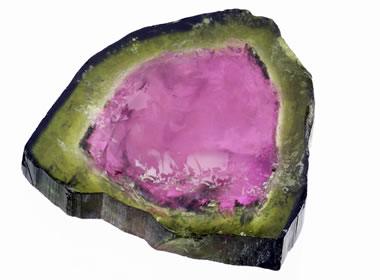
Tourmaline crystal cross-section: A "slice" of watermelon tourmaline which shows the pink interior, green outer layer, and triangular shape of the crystal. This specimen shows the origin of the "watermelon" name. Image copyright iStockphoto / Sun Chan.
Color-zoned crystals are often sawn into thin cross-sections and polished. These thin bicolor gems can be very attractive. The most popular bicolor tourmaline is "watermelon tourmaline." It has a pink interior and a green rind - just like a slice of watermelon. The closer the colors match those of a real watermelon, the more people enjoy them and the higher the price.
Tourmaline crystals are also faceted to produce bicolor gems. "Watermelon" is again the most popular, but many other beautiful color combinations are cut.
Zoned tourmaline crystals often have clarity problems in the color-change area. If the color combination is attractive, minor clarity problems usually do not have a major impact on their desirability or price.
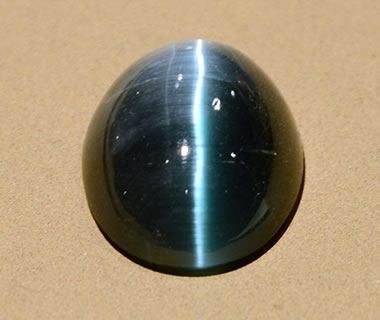
Cat's-Eye Tourmaline: This specimen of tourmaline contains thousands of tiny reflective tubes. If you look closely you can see them running from left to right within the gem. When a beam of light from above strikes the gem, the observer sees a bright line of light reflecting from the tubes below the surface of the gem. This bright line is known as a "cat's-eye" and this gem is known as "cat's-eye tourmaline". This wonderful tourmaline is owned by the Edelsteinmuseum (Gemstone Museum) in Idar-Oberstein, Germany and the photo was taken by a photographer who works under the name of Vassil and places many of his photos in the public domain.
Cat's-Eye Tourmaline
Tourmaline is one of many minerals that can be chatoyant when cut into a gem. "Chatoyant" is a gemological adjective used to describe minerals that exhibit a "cat's-eye". Chatoyant tourmalines contain thousands of tiny parallel tubes that have the ability to reflect light. When a tourmaline crystal filled with these tubes is properly cut as a cabochon, a line of bright light known as a cat's-eye will be reflected from the dome of the cabochon. The proper orientation is obtained by cutting the cabochon with the tubes paralleling the base of the cabochon and crossing the long dimension of the cabochon at a right angle.
Cat's-eye gems are fun to observe because the "eye" will move back and forth across the dome of the stone in three situations: 1) when the stone is moved under the light, 2) when the source of light is moved, and 3) when the head of the observer is moved.
Video: Pleochroism in Tourmaline: This video demonstrates pleochroism in two short sections of tourmaline crystals. The crystal sections are lightest when viewed perpendicular to the c-axis of the crystal (the side being held by the gem tweezers) and they are darkest when viewed down the c-axis of the crystal.
Pleochroism in Tourmaline
Tourmaline is a pleochroic mineral. That means its apparent color can change with different directions of observation. The color is usually darkest looking down the c-axis of the crystal (down the long axis). It is usually lightest when viewing perpendicular to the long axis of the crystal.
Cutting pleochroic gem materials requires skill and knowledge. Rough must be studied and oriented to produce a gem with pleasing face-up color. A light piece of rough can be cut with the table of a stone perpendicular to the c-axis of the rough to maximize color. Dark rough can produce lighter gems if it is cut with the table plane of the stone parallel to the c-axis of the rough. Some rough can be cut to nicely display two pleochroic colors in the face-up position. Many jewelry buyers enjoy these gems.
Color optimization of pleochroic rough is time-consuming, requires special skills, and usually involves sacrifice. Which will produce a higher profit? A stone of premium color with a lower carat weight, or a larger stone with a less desirable color? These are the economics of faceting tourmaline.
| Tourmaline Information |
|
[1] Gem Pegmatites of Minas Gerais, Brazil: The Tourmalines of the Aracuai Districts by Keith Proctor; Gemological Institute of America, Gems & Gemology, Volume 21, Number 1, Spring 1985.
[2] Gem Pegmatites of Minas Gerais, Brazil: Exploration, Occurrence, and Aquamarine Deposits by Keith Proctor, Gemological Institute of America, Gems & Gemology, Volume 20, Number 2, Summer 1984. [3] Cuprian Liddicoatite Tourmaline, by Yusuke Katsurada and Ziyin Sun; Gems & Gemology, Volume 53, Number 1, pages 34-41; Spring 2017. [4] "Paraiba"-Type Copper-Bearing Tourmaline from Brazil, Nigeria, and Mozambique: Chemical Fingerprinting by LA-ICP-MS, by Ahmadjan Abduriyim, Hiroshi Kitawaki, Masashi Furuya, and Dietmar Schwarz; Gems & Gemology, Volume 42, Number 1, pages 4-21; Spring 2006. [5] Paraiba Tourmalines: Brazilian vs. African by Rachael Taylor, updated by Maria Doulton; an article on The Jewellery Editor website, Posted April 2016, updated July 2018. [6] Colored Stone Reports and Services; a service page on the Gemological Institute of America website, last accessed October 2022. [7] Geographic Origin Determination of Paraíba Tourmaline by Yusuke Katsurada, Ziyin Sun, Christopher M. Breeding, and Barbara L. Dutrow; Gems & Gemology, Volume 55, Number 4, pages 648 to 659; Winter 2019. |
Tourmaline Treatments
Heat and irradiation are common treatments used to improve the color of tourmaline. Both of these treatments are commonly done after the stones have been cut and polished. They can be undetectable when viewed with a gemological microscope.
Heat treatment can lighten an undesirable tone in some materials and give some brownish stones a brighter, more desirable color. The results of heat treatment are usually permanent. Stones with liquid inclusions are not good candidates for heat treatment because heating can cause them to fracture.
Irradiation treatment can brighten many light-colored stones. The results are often reversed if the stones are heated. They can also be reversed over time with exposure to bright light.
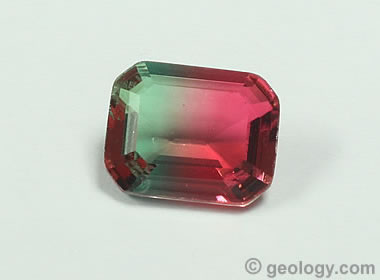
Imitation Tourmaline: An assembled-stone imitation of watermelon tourmaline. It consists of a thin wafer of colored plastic that is glued between two pieces of clear glass and then faceted.
Imitation Tourmaline
Imitation tourmaline is occasionally seen. The popular watermelon tourmaline and other parti-colored tourmalines are a common target of the imitators. Some assembled imitation stones consist of a thin wafer of colored glass or plastic, glued between two pieces of colorless glass.
These imitations are easy to detect with a microscope or loupe. If the stones are examined along the girdle, the edge of the colored wafer or the glue line can usually be seen. If the stones are examined by looking down through the table, bubbles or debris in the glue plane are sometimes visible.
Find Other Topics on Geology.com:

|

| ||

|

| ||

|

| ||

|

|


